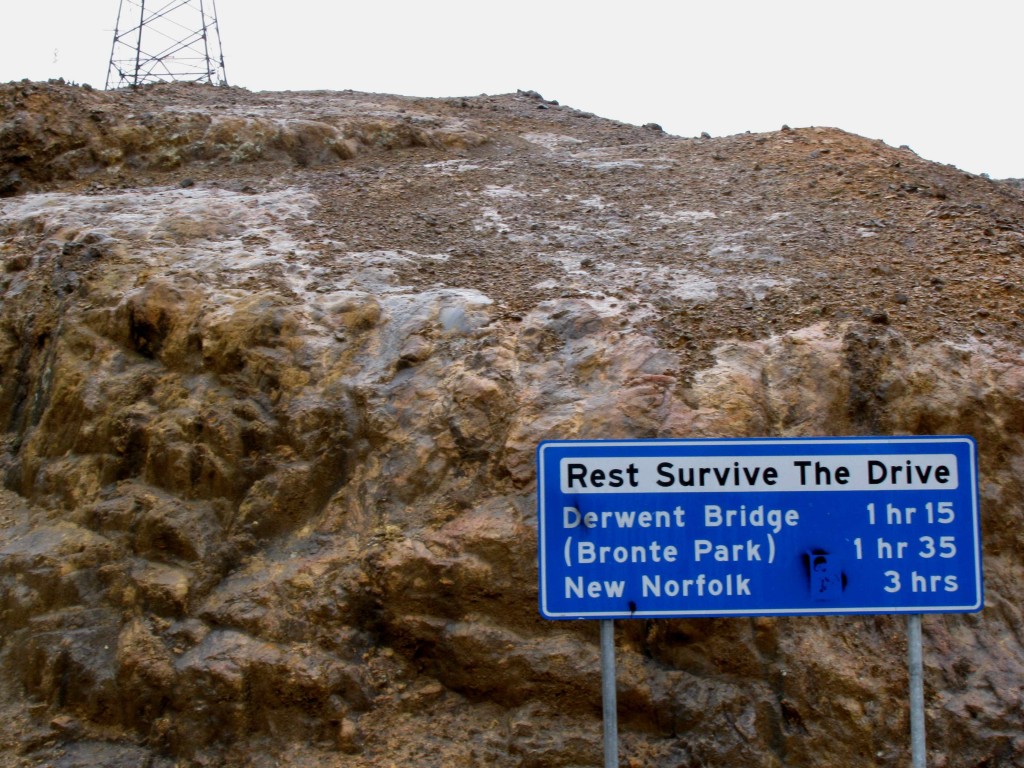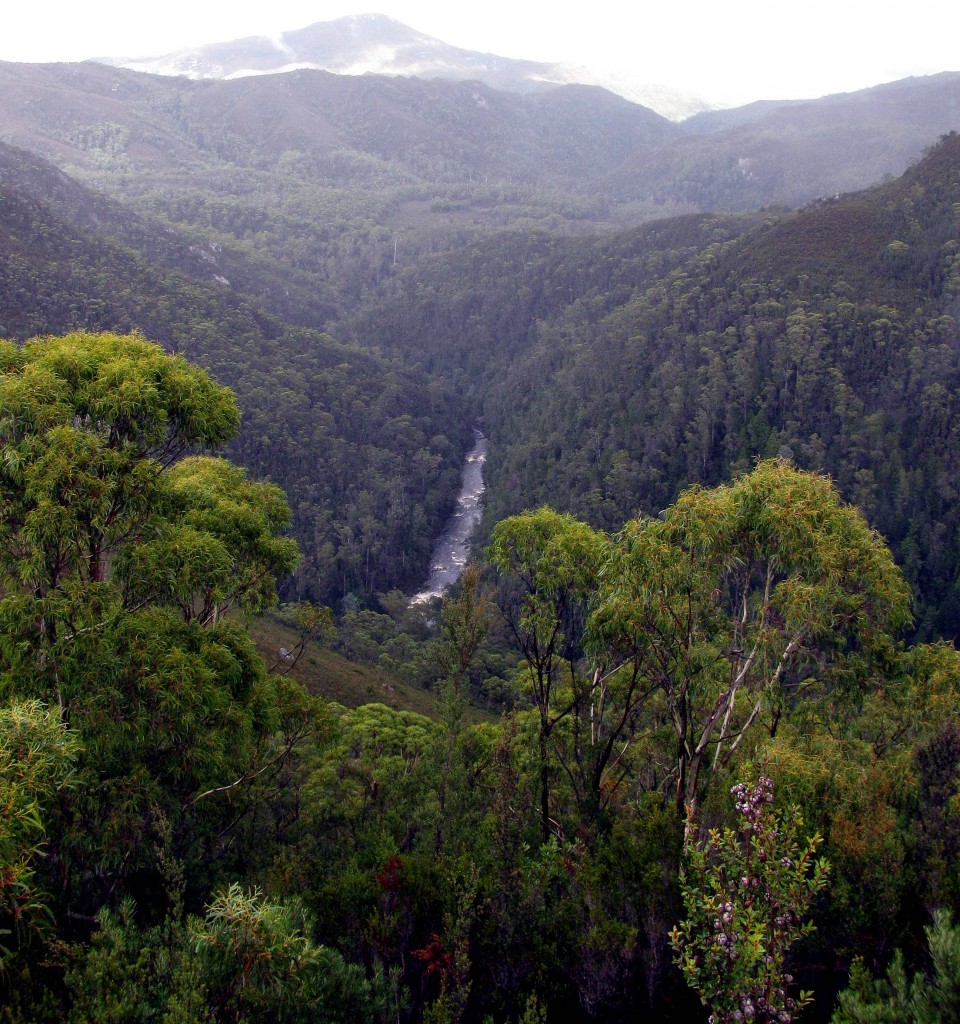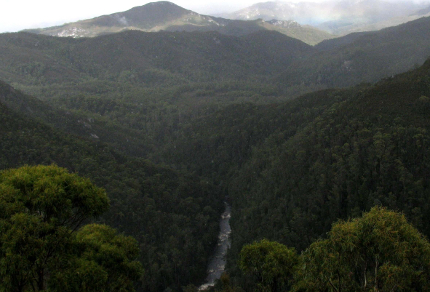At 5:50 a.m., I felt like a secret wrapped in darkness, the wild screams of kookaburras and wails of bush stone-curlews crying out There she is! There she is! while black flying foxes overhead echoed the blackness of the deepest night, the darkest shadows. I walked fast, in solitude for half an hour, pausing to watch fish in the river jump for dawn insects. Then the parkway came alive with the Ross River Knights cycling, running, exercising canine companions, and, like me, striving for improved muscle tone at the fitness track.
After my return to the house and breakfast with Vilis, I again waded into the forest of weeds in the yard, yanking them out easily from the sandy gravel of the walkways and the richer loam of the raised beds. Perhaps all my seasonal ponderings of Tuesday lit a fire under me, for I’ve begun to think of transplanting vegetables and vivid flowers into the raised beds.

Deforested and mined land near Queenstown, Tasmania (© Vilis Nams)
With my weeding came thoughts of land clearing on a much larger scale – Australian land clearing, of which we’d seen vivid examples in Tasmania. When I went online to gather some facts and figures, I noted an interesting dichotomy in the links, which fell into two distinct groups: 1) advertising for land clearing services, and 2) reports of the extent of land clearing in various parts of Australia, the latter nearly all presented by conservation organizations.
I learned from the World Wildlife Fund Australia that Queensland has the highest rate of land clearance on the continent,1 and that the state governments of Queensland and New South Wales have made major efforts since 2003 to end broad scale land clearing1,2. I saw a photograph of barren desert in western NSW that had been forested land cleared for agriculture3, and read that the Australian government has named land clearing as the top threat to Australian wildlife.3
Cutting and removing vast tracts of native vegetation creates a broad range of environmental problems. First and foremost, clear-cutting destroys or fragments highly diverse plant communities that provide habitats for a great range of animal species3,4. (For Australia as a mega-diverse country, see http://maginams.ca//2010/02/11/ .) Land clearing often causes soil erosion and the development of dryland salinity (a huge concern in the Murray-Darling Basin, which holds 40% of Australia’s farmland)3,4, as well as encouraging the invasion of weedy plant species and predatory animals that wouldn’t normally be found in an area.4 In Australia, the burning and decay of cleared vegetation accounts for 13% of the country’s carbon dioxide input into the earth’s atmosphere, which the WWF estimates is nearly as much as that caused by the entire transportation sector in the country.3 And, as has long been known, when native vegetation is cleared in order to create plantations of fast-growing trees or expansive crop fields, natural soil enrichment regimes are replaced by unnatural ones that degrade soil quality over time. As well, plantations and crops are monocultures low in biological diversity3 and highly susceptible to damage by pests and diseases.
Australian Government reports provided more intriguing statistics, one being that at the turn of the century, more bush had been cleared in Australia during the previous 50 years than during the 150 years before.5 Victoria has lost more of its native vegetation than any other state6 (on reading this, I recalled the stunningly beautiful mountain ash forest in Yarra Ranges National Park), and Tasmania has the country’s highest rate of land clearance in proportion to its small size.7 Having seen large tracts of clear-felled land and the prevalence of eucalypt and pine plantations in Tassie, the last of these facts didn’t surprise me. I was reminded of an interpretive sign in Mount Field National Park that described the park, which is home to some of the world’s tallest trees and sanctuary for diverse, altitude-dependent ecosystems, as “a conservation island in a sea of farming and forestry.”
To counteract the negative statistics, I looked through pages of photographs near the beginning of Forest Trees of Australia, an encyclopedic tome written by no less than nine authors.8 The photographs illustrated tropical and temperate rainforests thick with rich green life, as well as tall open forests with glorious trunks rising high. They showed crazy-looking stands of mallee leaning in all directions, sparse mulga shrubland growing on rocky, red soil, and many other of Australia’s native forests. There was such richness, such beauty, such evidence of these forests’ and woodlands’ incredibly long and intimate relationship with the soils and climates of this country. What Australian would choose to lose all of that to more land clearance?

View from Donaghy’s Hill Lookout, Franklin-Gordon Wild Rivers National Park, Tasmania (© Vilis Nams)
References:
1. World Wildlife Fund Australia. Queensland land clearing. Accessed 1-Apr-2010. http://www.wwf.org.au/ourwork/land/qldlandclearing/
2. World Wildlife Fund Australia. New South Wales land clearing. Accessed 1-Apr-2010. http://www.wwf.org.au/ourwork/land/nswlandclearing/
3. World Wildlife Fund Australia. Land clearing. Accessed 1-Apr-2010. http://www.wwf.org.au/ourwork/land/clearing/
4. Australian Government, Department of the Environment, Water, Heritage and the Arts. Biodiversity hotspots. Updated 28-Jul-2009. Accessed 17-Feb-2010. http://www.environment.gov.au/biodiversity/hotspots/index.html
5. Australian Government, Department of the Environment, Water, Heritage and the Arts. State of the Environment Report 2001. Updated 10-Dec-2009. Accessed 5-Jun-2010. http://www.environment.gov.au/soe/2001/publications/key-findings/index.html
6. Australian Government, Australian Natural Resources Atlas. Biodiversity and Vegetation – Victoria. Updated 15-Jun-2009. Accessed 5-Jun-2010. http://www.anra.gov.au/topics/vegetation/clearing/vic/index.html
7. Wendy Stevens. Declining Biodiversity and Unsustainable Agricultural Production – Common Cause, Common Solution? Parliament of Australia Parliamentary Library, Research Paper 2 2001-02. Updated 27-Sep-2001. Accessed 5-Jun-2010. http://www.aph.gov.au/library/pubs/rp/2001-02/02RP02.htm#Tasmania
8. D.J. Boland, M.I.H Brooker, G.M. Chippendale, N. Hall, B.P.M. Hyland, R.D. Johnson, D.A. Kleining, M.W. McDonald and J.D. Turner. Forest Trees of Australia. 2006. CSIRO Publishing, Collingwood, Victoria. 736 p.


